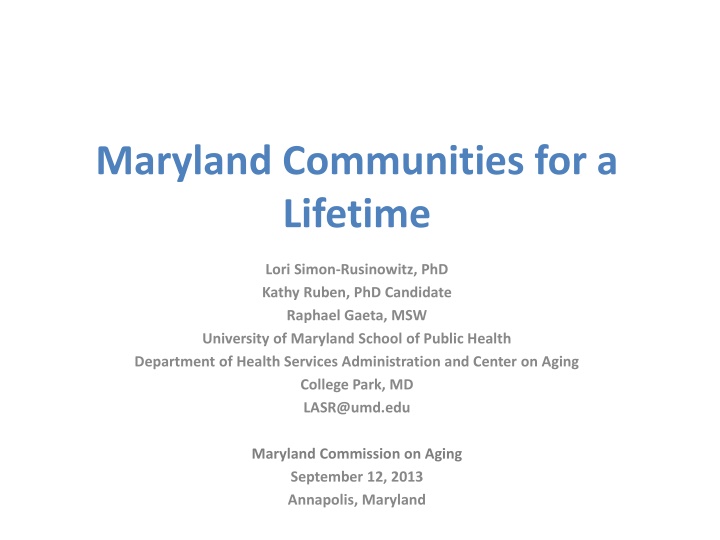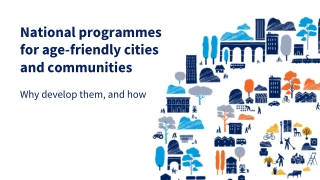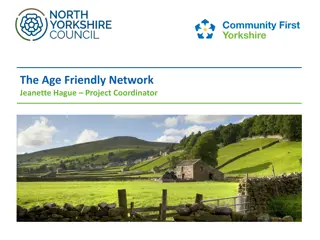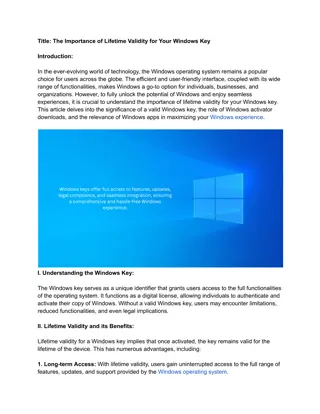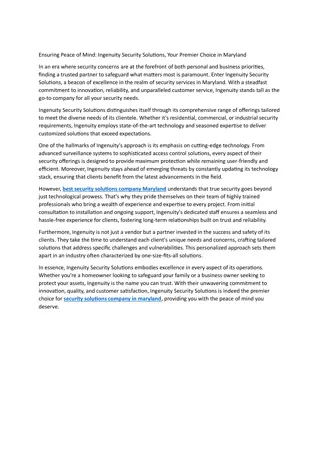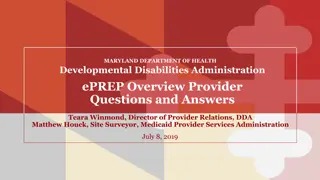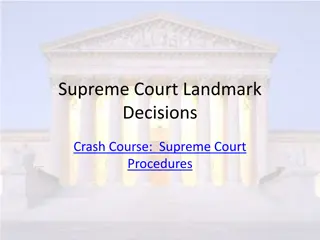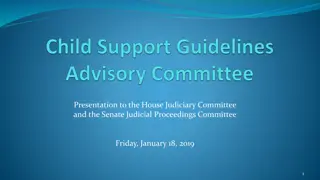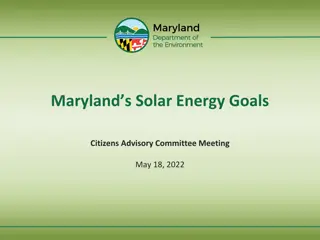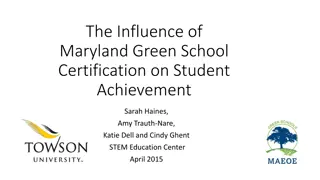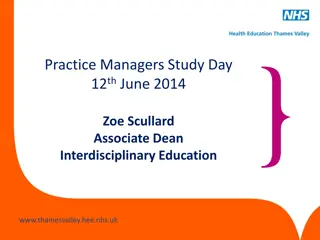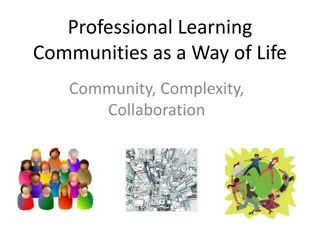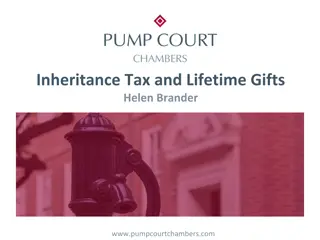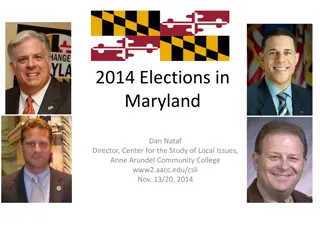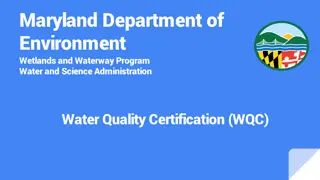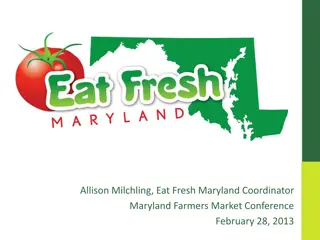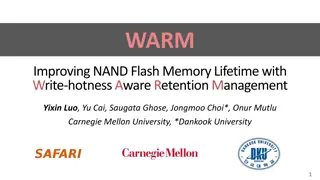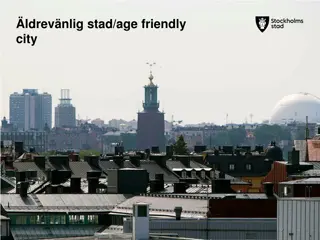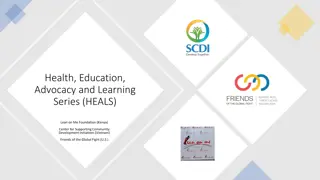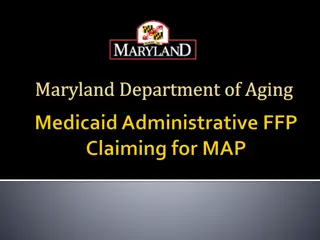Maryland Communities for a Lifetime: Supporting Age-Friendly Initiatives
Maryland Communities for a Lifetime focuses on creating age-friendly environments to support the elderly population and address the challenges of aging in the community. The program emphasizes the importance of home and community-based services, recognizing the essential role of family caregivers. It also highlights the economic value of unpaid caregiving contributions and the need for initiatives that improve access to support services for aging individuals.
Download Presentation

Please find below an Image/Link to download the presentation.
The content on the website is provided AS IS for your information and personal use only. It may not be sold, licensed, or shared on other websites without obtaining consent from the author.If you encounter any issues during the download, it is possible that the publisher has removed the file from their server.
You are allowed to download the files provided on this website for personal or commercial use, subject to the condition that they are used lawfully. All files are the property of their respective owners.
The content on the website is provided AS IS for your information and personal use only. It may not be sold, licensed, or shared on other websites without obtaining consent from the author.
E N D
Presentation Transcript
Maryland Communities for a Lifetime Lori Simon-Rusinowitz, PhD Kathy Ruben, PhD Candidate Raphael Gaeta, MSW University of Maryland School of Public Health Department of Health Services Administration and Center on Aging College Park, MD LASR@umd.edu Maryland Commission on Aging September 12, 2013 Annapolis, Maryland
Agenda I. Introduction: Who can Benefit from Maryland Communities for a Lifetime? The Importance of Age-Friendly Communities III. What is a Community for a Lifetime? IV. Communities for a Lifetime in Other States V. Home and Community Based Services: The Heart of Communities for a Lifetime VI. Initiatives on Age-Friendly Communities VII. University of Maryland Pilot Project in Prince George s County VIII.Discussion II.
Introduction: Who can Benefit from Maryland Communities for a Lifetime?
Family Caregivers (AARP Public Policy Institute 2011) 65 % of people needing LTSS rely exclusively on unpaid caregivers 30% of people needing LTSS supplement unpaid care with paid caregivers 59-75% of caregivers are women Average age of caregivers: 49 years old; however 25% are between 65 - 75 years old Caregivers provide approximately 20 hours a week of unpaid care
Family Caregivers Caregivers perform diverse tasks, including: personal care, medication management, health care coordination, household tasks, bill paying, transportation, companionship, emotional support, etc. Family care often affects caregivers physical and emotional health, own financial situation, retirement security, career, and social network. The estimated economic value of unpaid caregiving contributions in U.S. was $450 billion in 2009.
The Importance of Age-Friendly Communities
Importance of Age-Friendly Communities Address a growing elderly population and an economic imperative associated with elder care. Honor consumer preferences to remain at home and in the community as they age. Address challenges to aging in the community, and provide needed supports. Improve access to existing supports for aging in the community.
Projected Aging in the U.S. (Number of Americans age 65 and older in millions; U.S. Census Bureau, 2005 & 2010) 100 90 80 70 60 50 40 30 20 10 0 Year 2004 2020 2030 2050
Maryland In 2000, 15 % (801,036) of Maryland s 5.3 million people were 60 years or older. By 2030, 25% of Maryland's projected population of 6.7 million will be 60 years or older. Maryland Department of Aging http://www.aging.maryland.gov/Statistics.html
2011 Estimates of Persons 60 and Older for Maryland's Jurisdictions Source: http://www.aging.maryland.gov/documents/2012AnnualReport.pdf
Marylands 60+ Population Percent Change Projections by Jurisdiction, 2010-2040 Charles Co. 135% Frederick Co. 127% St. Mary's Co. 126% Howard Co. 111% Cecil Co. 111% Calvert Co. 103% Prince George's Co. 88% Carroll Co. 84% Queen Anne's Co. 84% Montgomery Co. 81% Harford Co. 73% State of Maryland 69% Washington Co. 66% Caroline Co. 65% Worcester Co. 63% Anne Arundel Co. 61% Kent Co. 58% Wicomico Co. 54% Dorchester Co. 51% Garrett Co. 42% Talbot Co. 40% Baltimore Co. 39% Somerset Co. 26% Baltimore City 20% Allegany Co. 8% Source: http://www.aging.maryland.gov/documents/2012AnnualReport.pdf
Challenges to Aging in the Community Health problems for many elders Caregiver needs Safety concerns Housing needs Financial needs Limiting attitudes about elders
What is a Community for a Lifetime?
Definition: MD Chapter 295, SB 822 The Department [of Aging] shall recommend criteria that local jurisdictions may use to certify communities for a lifetime, including: 1. The extent to which a community has sought and plans to expand public health, prevention, and wellness programs that serve older adults; 2. The extent to which a community has sought and plans to expand affordable transportation options; 3. The extent to which a community has sought and plans to expand affordable rental housing and the ability to own affordable homes; 4. The extent to which a community has sought and plans to expand employment, civic engagement, recreation, and leisure options for older adults; and 5. The extent to which a community has sought and plans to expand other initiatives that boost the abilities of older adults to age in place. Source: http://mgaleg.maryland.gov/2011rs/chapters_noln/Ch_295_sb0822E.pdf
World Health Organization Guidelines for Age-Friendly Cities Outdoor spaces and buildings Transportation Housing Social participation Respect and social inclusion Civic participation and employment Communication and information Community support and health services
Communities for a Lifetime in Other States
Maryland Communities for a Lifetime: Informed by Florida Criteria Department of Elder Affairs, Communities for a Lifetime Bureau (1999) Goal To assist Florida cities, towns and counties in planning and implementing improvements that benefit their residents, youthful or elder. Communities use existing resources and state technical assistance to make improvements in housing, health care, transportation, accessibility, business partnerships, community education, employment, volunteer opportunities and recreation. Source: http://www.communitiesforalifetime.org/docs/blueprint2007web.pdf
A Look at Other States Minnesota Laws of Minnesota, 2009, Chapter 60 Program website: www.mnlifetimecommunities.org Maryland Chapter 295, Acts of 2011 Maryland Department of Aging website: www.aging.maryland.gov States with programs and proposed CFAL legislation Indiana (program of Indiana University and partners) Hoosiers communities for a lifetime, Senate Bill No. 277 (last considered in 2012) Program website: www.lifetimecommunities.org States with programs but no CFAL law/legislation Florida (partnership of the Department of Elder Affairs and AARP) Program website: www.elderaffairs.state.fl.us/doea/cfal.php and www.communitiesforalifetime.org Michigan Program website: http://www.michigan.gov/osa/1,4635,7-234-64083_64552---,00.html Virginia Blueprint for Livable Communities: http://www.aarp.org/content/dam/aarp/livable- communities/plan/planning/virginias-blueprint-for-livable-communities-2011-aarp.pdf
Home and Community Based Services: The Heart of Communities for a Lifetime
Participant Expectations & Preferences Remain at home with family and within community Participant-directed options offer: increased choice, control, and flexibility than traditional services ability to hire own workers, including family and friends if preferred
Recent Federal Initiatives to Expand Home and Community-Based Services 2007 AoACommunity Living Program 2008 Veterans Directed HCBSProgram 2009: Independence at Home Act 2010: Patient Protection and Affordable Care Act Community First Choice Option Balancing Incentives Program Money Follows the Person (expanded) CLASS Act (Community Living Assistance Service and Supports) . Will not be implemented.
Aging and Disability Resource Centers 2003 Maryland one of first 12 states to receive grant to develop 2 013 Maryland Maryland Access Point (MAP) program statewide Statewide public web-based data resource Statewide standards for Options Counseling Expanded population served to all individuals with a disability Central partner in Medicaid Rebalancing Programs Umbrella for other rebalancing initiatives MAP website: http://www.marylandaccesspoint.info/
National ADRC Active in 54 States and Territories Partner with: Centers for Medicare and Medicaid Services U.S. Department of Veterans Affairs Administration for Community Living Administration on Aging Office of Disabilities Administration for Developmental Disabilities Major Player in National Rebalancing
What are Participant-Directed Services? Participant-directed services: long-term services and supports to help people of all ages with all types of disabilities maintain their independence and determine what personal care services work best for them.
Service Models Cash and Counseling Model Traditional Model professional decision-making agency oversight rules and restrictions regarding the timing, duration, amount, and scope of services Participant-Directed Models participants have more control over their services One of the most flexible models of participant-direction Allows participants the authority to manage a personal care budget Counselors provide advice and program information, quality monitoring, and training in budgeting, planning, recruiting and hiring workers Participants hire, supervise, and fire their own personal care workers (including relatives) Participants may purchase other personal assistance goods and services.
Cash and Counseling Demonstration & Evaluation States and Expansion States Demonstration Arkansas Florida New Jersey Expansion Alabama Illinois Iowa Kentucky Michigan Minnesota New Mexico Pennsylvania Rhode Island Vermont Washington West Virginia
National Resource Center for Participant-Directed Services Mission: To infuse participant-directed options into all home and community-based services Current projects U.S. Administration on Aging Initiative to promote culture change from professional to empowerment approaches to services and supports U.S. Administration on Aging and Veteran's Administration Initiative to create a network of Veterans-Directed programs in every state Robert Wood Johnson Foundation-funded Environmental Scan of Behavioral Health and Participant-Direction
Initiatives on Age-Friendly Communities
World Health Organization Guidelines for Age-Friendly Cities Outdoor spaces and buildings Transportation Housing Social participation Respect and social inclusion Civic participation and employment Communication and information Community support and health services
Community Innovations for Aging in Place Grantees Community efforts to help elders maintain their independence and age in their homes. 2009: Over 200 applications received. 14 organizations representing diverse communities nationwide received awards. Administration on Aging http://www.aoa.gov/AoA_programs/HCLTC/CIAIP/i ndex.aspx#Purpose
Administration on Aging Grantee Projects (examples) Atlanta Regional Commission, Atlanta, GA A community capacity-building project for aging in the community Boston Medical Center, Boston, MA Services to Help At-Risk Elders Age in the community (SHARE) Catholic Charities, Kansas City, MO Caring Communities Resource Centers The Coordinating Center, Millersville, MD Opting for Independence
Administration for Community Living New agency announced April 16th, 2012: Administration for Community Living (ACL), in the Department of Health and Human Services. Merges the Administration on Aging, Administration on Developmental Disabilities, and Office of Disability. Goal : increase access to community supports and full community participation; focus attention and resources on the needs of elders and people with disabilities.
AARP and WHO: A Shared Vision The AARP Network of Age-Friendly Communities helps participating U.S. communities adopt features like safe, walkable streets, better housing and transportation options, access to key services, and opportunities for residents to participate in community activities. Benefits include access to: global network of participating communities aging experts peer to peer opportunities information and best practices Source: http://www.aarp.org/livable-communities/network-age-friendly-communities.html
AARP and WHO: A Shared Vision (Contd) Ten cities have joined the AARP Network New York City, NY; Washington, DC; Philadelphia, PA; Portland, OR; Austin, TX; Des Moines, IA; Honolulu, HI; Auburn Hills, MI; Wichita, KS; Westchester County, Brookhaven, and Chemung County, NY; and Macon- Bibb County, GA Affiliated with the World Health Organization s (WHO) Age-Friendly Cities and Communities Program 137 communities in 21 countries Source: http://www.aarp.org/livable-communities/network-age-friendly-communities.html
Naturally Occurring Retirement Community (NORC) A NORC is a community with a concentrated population of older individuals (e.g., a residential building, housing complex, a neighborhood composed of age-integrated housing). U.S. Department of Health and Human Services Maryland has two NORCs operated by: Jewish Federation of Greater Washington, Rockville Jewish Federation in Baltimore
Housing Plus Services (HPS): LeadingAGE Center for Applied Research HPS is an umbrella term coined by the National Low Income Housing Coalition to capture the phenomenon of combined housing and supportive services to help low-income people achieve housing stability. For older adults, this means combined housing and supportive services (e.g. healthcare, support services, case management, life skills, crisis management, social and community engagement) to prevent institutionalization and facilitate aging in place. Source: http://nlihc.org/issues/other/hps Source: http://www.leadingage.org/Center_for_Housing_Plus_Services.aspx
Housing Plus Services (HPS): LeadingAGE Center for Applied Research (Cont d) HPS Learning Collaborative 12 community teams that develop and pilot HPS programs to: Identify the essential elements and practices of HPS strategies. Develop indicators and mechanisms to measure whether HPS models can improve health outcomes for seniors while creating cost savings for the health care system. Explore how regulatory and financing models could help HPS to scale 1 Maryland community team Associated Catholic Charities in Baltimore, MD, working with Greater Baltimore Medical Center as its service provider partner. Source: http://nlihc.org/issues/other/hps Source: http://www.leadingage.org/Center_for_Housing_Plus_Services.aspx
The Village Movement The Village Movement: helps elders remain in their homes and communities by organizing programs and services that help older people lead a safe, healthy and productive life. http://www.cbsnews.com/8301-505146_162-39942521/assisted-living-creative- villages-concept-can-help/
The Village Movement Pioneered by the Beacon Hill Village in Boston, founded in 2001 97 operating villages in the U.S. with another 78 locations in the planning stage Source: http://www.vtvnetwork.org/content.aspx?page_id=1905&club_id=691012#search_results
The Village Movement Villages can complement other community approaches to aging such as NORCs and Area Agencies on Aging programs.
Villages Features Member/consumer-driven, grass-roots organizations (self-governing) Run by volunteers and paid staff Coordinate access to affordable services (transportation, health and wellness programs, home repairs, social and educational activities and trips Vetted- discounted providers
Village Features Strategic partnerships vs. duplicating services Whole person focus (community building, member services, healthy aging) Reduced-fee memberships Volunteerism, peer assistance Intergenerational connections
Maryland At Home Chesapeake Aging in Place Hyattsville Bannockburn Neighbors Assisting Neighbors Burning Tree Village Chevy Chase at Home Downtown Silver Spring Senior Village
Village Networks (select Village Networks nationwide) Beacon Hill Village (Boston, MA) Community Without Walls (Princeton, NJ) 60-Plus Club (Noblesville, IN) At Home In Greenwich (CT) Avenidas Village (Palo Alto, CA) Capitol Hill Village (Washington, DC) Front Desk Florence (OR) Gramatan Village (Bronxville, NY) Lincoln Park Village (Chicago, IL) Penn's Village (Philadelphia, PA) SAIL Support for Independent Lives (Madison, WI) Tierrasanta Project (San Diego, CA) Washington Park Cares (Denver, CO
Policy Brief Recommendations Develop a Maryland Communities for a Lifetime website so existing resources are accessible in one location. Establish a statewide or regional coalition to support communities in their efforts to develop/expand age-friendly communities (e.g., Westchester County Center for Aging in Place, Metropolitan Atlanta Lifelong Communities) Sponsor a statewide or regional symposium focused on Communities for a Lifetime
University of Maryland Pilot Project in Prince George s County
Creating Age-Friendly Communities: Investigating Needs and Preferences of Senior Building Residents in Prince George s County Project Goal: To conduct a needs assessment of low income and racially/ethnically diverse communities in Prince George s County to inform the development of Communities for a Lifetime tailored for this population. The project supports the 2011 Maryland Communities for a Lifetime Act. Project Approach: The two-part project comprises: 1) key stakeholder focus groups with Prince George s County leaders; elderly residents of two low-income senior buildings; and family members of building residents and 2) review and synthesis of existing County data to describe the needs of County elders.
Creating Age-Friendly Communities: Investigating Needs and Preferences of Senior Building Residents in Prince George s County (Cont d) Timeline: Focus group development and recruitment (Fall 2013) Focus groups conducted (Winter 2013/2014) Project report (Spring 2014) Overall Goal: Explore the development of a university/state/county partnership to implement Maryland Communities for a Lifetime.
